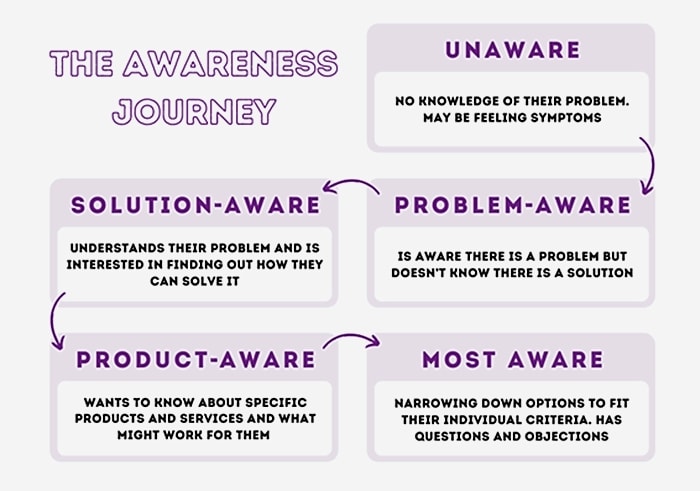Ever wondered how to implement behavioral progressive profiling throughout your potential customers' awareness journey so you can drive demand generation?
In a "perfect" world, your ideal customer would read one blog post, see one ad or landing page, and immediately click the Buy Now button.
Unfortunately, that's not how modern marketing works—or how most prospects behave.
Most marketers are in the business of building trust and nurturing relationships with potential customers—because it takes time for most people to be ready to buy.
We know that around 70% of the buying decision is made before potential buyers get in touch with a company. And as potential customers move along the awareness journey, we need to collect information from them at each stage to inform and nurture them as necessary.
That approach allows us to service potential customers in the way they need, but it also helps us learn more about them, ensuring we can inform Sales when a lead is Sales qualified and ready to speak to us about buying.
This article will explore what behavioral progressive profiling is and how it differs from what marketing automation companies want you to think progressive profiling is.
Progressive Profiling vs. Behavioral Progressive Profiling: What's the Difference?
Let's address the elephant in the room before we continue.
The information surrounding progressive profiling from most marketing automation platforms is a little too simplistic and shallow.
Those platforms describe progressive profiling as the act of progressively collecting more contact information through a series of web forms.
That's not wrong!
But it's also not enough.
To understand the human motivations behind the purchase, and use those motivations to our advantage, we need to go deeper.
It's not enough just to collect contact information at a handful of points in the purchase cycle. Instead, we need to work to understand behavior and use that understanding to inform where prospects are on the automation journey.
And that's why behavior-based progressive profiling is preferable to traditional progressive profiling.
Behavior helps us move potential customers from Marketing-qualified leads (MQL) to Sales-qualified seads (SQL), at which point they are primed to talk to the sales team and actually purchase.
Ultimately, marketing departments can use behavioral understanding to generate better leads.
To better understand how that works, let's look more closely at the differences between progressive profiling and behavioral progressive profiling,
What Is Progressive Profiling?
First, let's define progressive profiling in its most basic form:
Progressive profiling is a method of segmenting your audience based on information progressively collected from Web forms on your site.
What does that process look like in action?
Rather than getting prospects to fill out long, time-consuming forms, you can create dynamic forms that change based on what you already know about a particular lead. As a result, every time you get an MQL to fill out a form, you progressively learn a little more about that lead.
For example, you might ask for an email and name in the first form (you should always be doing this...). Then, as your prospect moves through the customer journey, you can request progressively more data based on their awareness and readiness to buy.
This method allows you to learn more relevant and valuable information with each form. Moreover, it also keeps the forms short and easy to fill in.
Asking for three pieces of information vs. six pieces of information increased conversion by 10%, OptinMonster found.
Progressive profiling reduces overwhelm and allows you to guide prospects through to SQL based on how someone is interacting with your site.
>> Related content: Progressive profiling: behavioral segmentation from customer behavior
What Is the Problem With Traditional Progressive Profiling?
Progressive profiling in the form that most marketing automation platforms promote is, simply put, shallow. It doesn't give us a deep enough understanding of exactly where the customer is in the awareness journey.
It is more effective than lead scoring, which merely tells you when prospects are engaged, not necessarily when a prospect is ready to speak to Sales.
Lead-scoring is the process of assigning values, usually "points," to each lead that lands in your funnel. Leads are given scores (points) based on various attributes. The cumulative score helps you and your sales team prioritize whom to focus energy on and therefore increases the rate at which your leads turn into customers.
Because lead scoring focuses on engagements, it doesn't allow us to figure out what level of awareness a prospect actually has. It doesn't enable us to figure out whether they have buying intent.
Most people use that lead engagement as a trigger for Sales to speak to a prospect. Often, however, lead-scoring triggers too soon, resulting in disengaging your leads and annoying them. Even if leads are qualified, an estimated 50% are not ready to buy yet.
The version of progressive profiling that most marketing automation companies espouse simply collects more information. But collecting more data doesn't necessarily inform a behavioral understanding, whereas that sort of understanding would significantly increase your chances of closing a sale.
What Is Behavioral Progressive Profiling? (And Why Is It More Effective?)
In a nutshell, behavioral progressive profiling is learning more about people based on their progressive interactions with you.
The key here is learning!
The ultimate aim of behavioral progressive profiling is to understand what current and past behaviors mean. And then to use that understanding to predict future behavior.
It is not surface-level information, such as what position people hold within a business. It's about getting into their psyche and understanding how their displayed behavior and content consumption predict their buying intent.
via GIPHY
Behavioral progressive profiling allows us to dig into where potential customers are in the awareness journey and what their sales intent is. And when we know that, we know what content they need to solve their current pain point to move them toward purchase.
How the Awareness Journey Informs Behavioral Progressive Profiling
A common problem is that businesses create "random acts of content": superficial content that is not strategic; it's created simply to get something up on the site.
With behavioral progressive profiling, once people become "leads," marketing automation tools track their activity and see their clicks—how they go from one blog post or article to another.
Depending on the type of content and pages on your site they're visiting, we can determine where they are in their buyer journey. When your lead reaches a certain threshold in that journey, your marketing automation system queues the appropriate content for that lead.
That is why we focus so heavily on the awareness stages. If you are clever with the content you create, you can daisy-chain content together and offer up the right content at the right time—ensuring a quicker transition through MQL and into SQL.
The five awareness stages
There are five levels of awareness in the customer journey, and at what level they are in that journey dictates what information you give them and whether you'll get the conversion:
- Completely Unaware: Prospects don't know they have a specific need; they are just dealing with symptoms of a problem. They have zero ties to your brand or your solution.
- Problem-Aware: Prospects are aware they have a core problem and they are looking to understand it better. They aren't clear on the solutions available, including yours.
- Solution-Aware: Prospects can see a range of solutions available and all their benefits. But they haven't quite narrowed it down to one category of options.
- Product-Aware: Prospects are looking for specific products to fit their needs. They're matching what's in the marketplace to their set of criteria—built on the basis of what they have learned so far.
- Most Aware: Prospects know about your product; they know it will solve their problem and they are ready to buy. But to commit to purchasing, they need to justify and validate the reasons.

The Advantages of Behavioral Progressive Profiling
Behavioral progressive profiling, in contrast to simple progressive profiling, allows us to engage potential customers at the right time and in the right way: By virtue of the fact that they are interacting with a specific piece of content, they are telling you where they are in their journey and, therefore, what information they need next.
And that sales intent behavior—when people interact with lots of bottom-of-funnel content—is one of the ways we should be flagging that someone has moved from Marketing-qualified to Sales-qualified.
For example, if someone is visiting a pricing page or contact page after downloading buyer's guides and reading multiple bottom-of-funnel blogs, we know they have sales intent. They are likely ready to seriously speak to someone about buying.
At this point, we can mark that person as an SQL—better yet, a hot lead... just what your sales team loves!
>> Related content: How to create a data-driven content plan
How to Implement Behavioral Progressive Profiling Into Your Marketing
Implementing behavioral progressive profiling will allow you to identify sales intent and offer prospects the right content at the right time.
It allows you to anticipate your prospect's needs and fulfill those touch-points necessary to make purchases. It's an excellent way to show that you understand your potential customer, and thus it builds trust with them.
But it doesn't magically happen!
We can't sit back and wait for prospects to find what they need by themselves, magically. Instead, we need to create campaigns to nudge them in the right direction.
We can do that by tracking behavior and structuring our campaigns to anticipate and guide buyer behavior to increase demand generation.
Need some help with doing all that? MarketingProfs is happy to help. Reach out!
More Resources on Progressive Profiling
Five Best-Practices to Increase Registration Conversion




